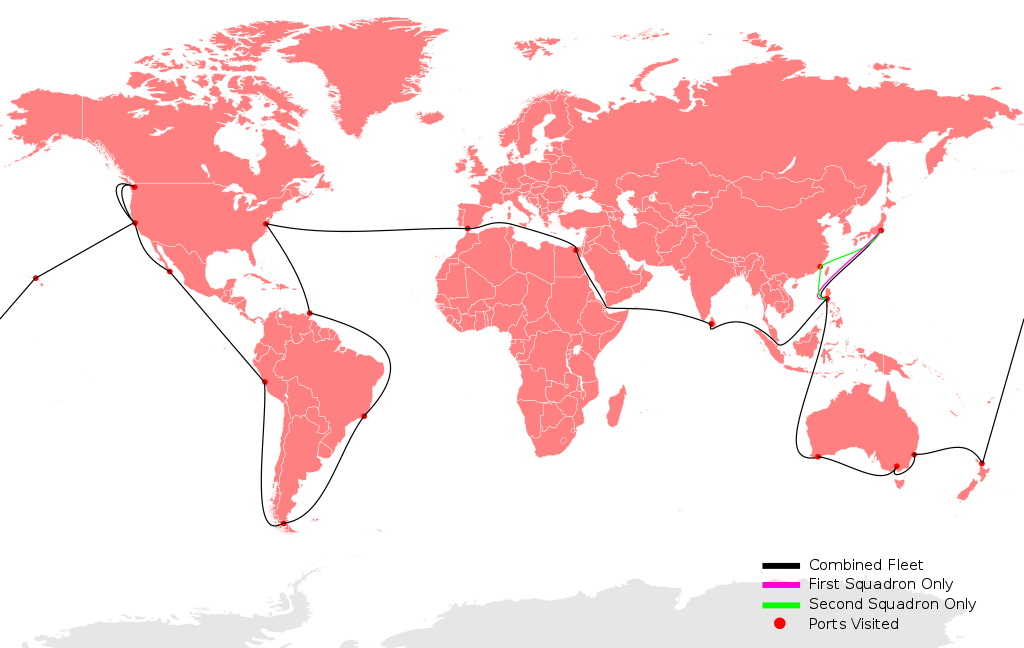Lessons from The Great White Fleet: The Need for Naval Readiness in the 21st Century
Using history to show the opportunity to project deterrence through naval diplomacy.
Most people don’t remember Teddy Roosevelt’s worldwide cruise of the Great White Fleet, but in an era of strategic competition with Russia and China, the significance of naval readiness is more important than ever.
In 1907, the U.S. found itself in a strategic competition with Japan, vying for control of the Pacific, as major powers in Europe took pity on our antiquated naval forces during the era of dreadnoughts and global maritime logistics.
In the wake of this dire environment, President Theodore Roosevelt gathered his warships, painted them from stem to stern in dazzling white, and prepared the fleet for a voyage the world would remember. As the ships were mustered to America’s eastern coast, many U.S. officials were skeptical of the feasibility of such a grand passage. Roosevelt planned to send his warships to six continents, showing the world the global capabilities of the U.S. Navy. These 16 battleships became known as the Great White Fleet.

After America’s victory in the Spanish-American war, the U.S. was eager to show itself on the world stage as a viable global power. Roosevelt responded to his strategic threats, like Japan, by sailing to their front door. Why? Because by doing so, the U.S. Navy was shown to be capable of deploying anytime, anywhere, regardless of where their ships were homeported.
The cruise of Roosevelt’s battle fleet worked as more than just global deterrence; it ensured our navy was ready to fight. In 1907, the U.S. navy was still learning the means required to compete against its strategic adversaries. The departure of the Great White Fleet would show U.S. policymakers the weaknesses of its fleet, the first of which is logistics. During the cruise, the navy would routinely require the aid of foreign collier vessels transporting coal to keep the fleet at sea. In the modern era, the U.S. has a much larger sustainment fleet. However, with the current state of U.S. foreign policy, our logistics fleet routinely stretches past its capacity.
The U.S. Navy plays a key role in showing American power abroad. Roosevelt knew this and used the voyage as a driving factor to build up America’s fleet and keep its ships ready, especially in peacetime.
In 21st-century warfighting, the U.S. Navy now plays an even larger role globally in keeping sea lanes free and open for commerce. In peacetime, American ships respond to natural disasters, humanitarian crises, and act as a critical component of our forward presence worldwide.
Similar to 1907, the U.S. today faces a strategic adversary in the Pacific. Unlike Roosevelt’s enemy Japan, the People’s Republic of China seeks to replace the U.S. on the world stage, and their recent global naval deployments are furthering that goal. The need for a funded, well-trained U.S. Navy is growing by the day.
Deterrence avoids war, and with the notion set by Russia’s invasion of Ukraine, China is eying America’s vulnerabilities in the Indo-Pacific. The deployment of the Great White Fleet showed the world that the U.S. was becoming both a world power and a naval power. The Navy plays a critical role in projecting U.S. strength today, as it did in 1907.
The key lesson from the cruise of the Great White Fleet is the need to have a strong, active navy to project deterrence abroad. The U.S. Navy today requires long lead time and intensive programs to build ships. With China and Russia pushing against U.S. sovereignty, the need for a ready battle force is at an all-time high.
The best time to start building back our Navy was yesterday; the second best is today. Let us all reflect on the Great White Fleet’s daring voyage as a time of American strength and courage that showed the world the capabilities of a global navy and how those same principles apply today.





